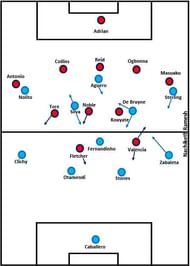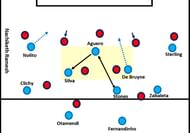Pep Guardiola faced a back three for the first time in England when his Manchester City team faced Slaven Bilic’s West Ham United. Thanks to a brace from Raheem Sterling and a Fernandinho goal, City cruised past the visiting team.
Teams:
Manchester City: Willy Caballero, Gael Clichy, Nicholas Otamendi, John Stones, Pablo Zabaleta; Fernandinho, David Silva, Kevin de Bruyne; Nolito, Sergio Aguero, Raheem Sterling.
West Ham United: Adrian, Angelo Ogbonna, Winston Reid, James Collins; Arthur Masuaku, Cheikhou Kouyate, Mark Noble, Gokhan Tore, Michail Antonio; Enner Valencia, Ashley Fletcher.
Guardiola, having used 4-1-4-1 in all the previous games this season, changed the line up slightly as Silva and De Bruyne played more central and narrow to make the shape seem like a 4-3-3. One of the very surprising aspects of Bilic’s West Ham was the usage a back three against Manchester City’s lone forward. West Ham started with a 3-5-2 formation.
Manchester City’s slightly altered look – West Ham back three challenge
To combat a packed opposition in the midfield and the prospect of facing a three-man defense, Guardiola played his two playmakers – Silva and De Bruyne – a bit deeper than their usual position in the earlier matches. In the previous games, where City played a 4-1-4-1 and both these players played more like #10s, against West Ham they were deeper and narrower and seemed like #8s.
With the aim of cancelling West Ham’s numerical upper hand in the midfield, which the visiting side could’ve achieved by staggering the shape, Guardiola intended to have Silva and de Bruyne involved in the build-ups closer to the center circle.
Also by dropping deeper, Silva and De Bruyne were towing the midfield and defensive line of the visiting team and were creating space for the wide players, the striker and one of the #8s to move into. The first goal was created in a similar situation in which the Belgian midfielder ran through the space between the lines.
Silva and De Bruyne were alternating between the center and half-spaces, supporting the center backs in making forward passes towards them while maintaining a central position and allowing diagonal inward passes from the wingbacks while moving to the half-spaces.
Also, the #8 far from the ball for City was a bit ball-oriented. This maybe because of two reasons. One, to support Aguero in laying off vertical balls. Two, to overload the ball near side.
Fernandinho, too, played more at the base of the midfield trio and rarely dropped deep. While pressing the central defenders of City, West Ham usually had two forwards.
To create a passing option behind the first line of press and also to draw out the two forwards wider so as to gain central penetration, Fernandinho was not dropping between the central defenders.
A back three line up of West Ham, against one forward felt like a silly decision from Bilic. By stepping up close towards Aguero, Silva and De Bruyne, they were able to cut short the passing options of the defenders of the visiting team.
While defending, with space in front of them, Ogbonna and Collins – the central defenders on either side of Reid, were being forced to move higher up to press the City players positioned in this space. This allowed room behind the defensive line for Aguero to run into.
If Reid and Co. decided to stay flat, Aguero was being presented with the opportunity of drifting from side to side and receive passes and support the ball carrier. Big space between the lines enabled the Argentine forward to drop deep to collect vertical passes and then lay them off to launch quick attacks on West Ham.
Zabaleta and Clichy in half-spaces but maintain width – Half-space overloads
Unlike the previous games, in which the wingbacks were changing to false fullbacks and were moving towards the center circle, Zabaleta and Clichy only moved as central as the half-spaces.
They also maintained width and supported their wingers in the wide zones to achieve 2v1 situations against West Ham’s wingbacks.
Their movement to half-space was purposeful, as the City wingbacks tried to distract and manipulate the movements of the wide players in West Ham’s midfield when the visiting team changed to a 5-4-1 formation. With Zabaleta and Clichy in half-space, the wide midfielders were not doubling up on the wingers as they were aware of the inward runs of City’s wingbacks.
This was creating 1v1 situations in the wings and half-spaces and since most of the City players were better players under such conditions, City was banking on qualitative superiority to overcome such 1v1s and then move on towards the space.
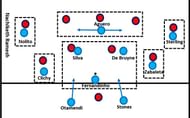
Since Silva and De Bruyne were dropping deeper than usual, City was creating a 3v2 kind of situation in the heart of the midfield. This was allowing Stones and Otamendi to occasionally raid into the opposition half.
Also, City midfielders were able to bypass the middle quite easily to the wings. Here the wingers were gaining the upper hand in 1v1 battles and were thus successfully stretching the defensive line of West Ham. As a result, gaps were being created between the players, which was making it easy enter the box.
When West Ham were pressing in the middle third with quite some ferociousness, situations of numerical and qualitative superiority were helping the play to take place in between the lines. This was probably one of the reasons why West Ham conceded so many fouls.
Sterling and Zabaleta were alternating between the wing and the half-space on the right side of the field. When Sterling was cutting inside during build-ups on the right side, Zabaleta was leaving his half-space position to move wider and maintain balance.
When Sterling was staying very wide during the attacking build-ups on the left side, Zabaleta was holding his position in the half-space in order to force West Ham to play narrow and free up space for his wing partner.
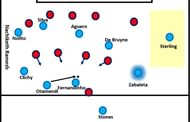
Zabaleta, here, is an extra passing option for Sterling, who is free to receive the pass. Zabaleta is not marked, which makes it even easier as he can run directly through the half-space and pass the ball to his teammates after forcing West Ham to press.
Also, note how Zabaleta’s half-space position is narrowing West Ham. He is allowing Sterling to stay as wide as possible and De Bruyne to be ball oriented.
In the above graphic, if one skips the positioning of rest of the City players, then justice is not being done. It is not just Zabaleta’s position, but it is also the position and the movements of the rest of the players that unlocked more space for Sterling. See that Silva, Aguero, and De Bruyne can all receive the pass.
This only makes West Ham to be over cautious and stay compact on the ball near side. The pass from Otamendi, a half-space to center switch, and the Hammers move closer to Fernandinho and cover his vertical passing options, which again opens the lane to Sterling.
Half-space overloads and switches, which I have explained as one of the ways to beat tight defenses, was a characteristic of Manchester City’s play. The home team was also creating rhombuses with wingback and near side #8 in half-spaces, supported by winger and Fernandinho, to progress the play through the compact space or to further tease the opponents.
City focused on beating 1v1 on the wing, in order to enter the central zones while patiently building from the back. To support the wingers during such situations the wingbacks were staying wide and on the edge of the half-space closer to the wing.
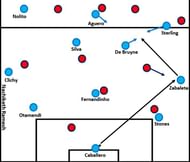
Sterling was the under loaded side player and Nolito mainly played with the ball close to him. This was one of the main reasons why we saw Zabaleta in the center (ball-oriented) and Clichy in wider positions than the Argentine.
Are City in a good shape to face Manchester United after the international break?
This match showed how well Guardiola had prepared for West Ham’s back three shape. Manchester City through half-space teasing and movements in the space between the line used the weakness of the visiting team to score twice early in the game. Had it not been for the ‘never give up’ attitude and small tweaks from Bilic, West Ham couldn’t have had that one goal at all.
We saw Caballero being involved more in the play. He was quick, more agile than Joe Hart against Steaua Bucuresti, and made some quick thinking to get out of tricky situations. De Bruyne was not that adept to play the deeper role and Guardiola might revert back to a 4-1-4-1 with him and Silva as #10.
Except for Aguero, who might miss due to suspension, everyone else seems to be fit at the moment to face Manchester United.
With good results and smoother than expected transition from a more English style to a style which Guardiola prefers, City players must now be beaming with confidence.
